Flexible Sample Environments for the Investigation of Soft Matter at the European Spallation Source: Part III—The Macroscopic Foam Cell
Abstract
:1. Introduction
2. Instrumental Concept and Performance
2.1. General Construction
2.2. Gas Flow Control
2.3. Temperature Control
2.4. Sample Positioning
3. Neutron Test Measurements
4. Conclusions
Author Contributions
Funding
Institutional Review Board Statement
Informed Consent Statement
Data Availability Statement
Acknowledgments
Conflicts of Interest
References
- Garoby, R.; Vergara, A.; Danared, H.; Alonso, I.; Bargallo, E.; Cheymol, B.; Darve, C.; Eshraqi, M.; Hassanzadegan, H.; Jansson, A.; et al. The European Spallation Source Design. Phys. Scr. 2017, 93, 014001. [Google Scholar] [CrossRef]
- Andersen, K.; Argyriou, D.; Jackson, A.; Houston, J.; Henry, P.; Deen, P.; Toft-Petersen, R.; Beran, P.; Strobl, M.; Arnold, T.; et al. The instrument suite of the European Spallation Source. Nucl. Instrum. Methods Phys. Res. Sect. A 2020, 957, 163402. [Google Scholar] [CrossRef]
- Jackson, A.J.; Kanaki, K. ESS Construction Proposal LoKI—A Broad-Band SANS Instrument. 2013. Available online: https://europeanspallationsource.se/sites/default/files/files/document/2017-09/loki_proposal_stc_sept2013.pdf (accessed on 12 April 2021).
- Jaksch, S.; Martin-Rodriguez, D.; Ostermann, A.; Jestin, J.; Duarte Pinto, S.; Bouwman, W.G.; Uher, J.; Engels, R.; Frielinghaus, H. Concept for a time-of-flight Small Angle Neutron Scattering instrument at the European Spallation Source. Nucl. Instrum. Methods Phys. Res. Sect. A 2014, 762, 22–30. [Google Scholar] [CrossRef] [Green Version]
- Jaksch, S.; Chennevière, A.; Désert, S.; Kozielewski, T.; Feilbach, H.; Lavie, P.; Hanslik, R.; Gussen, A.; Butterweck, S.; Engels, R.; et al. Technical Specification of the Small-Angle Neutron Scattering Instrument SKADI at the European Spallation Source. Appl. Sci. 2021, 11, 3620. [Google Scholar] [CrossRef]
- Schmid, A.J.; Wiehemeier, L.; Jaksch, S.; Schneider, H.; Hiess, A.; Bögershausen, T.; Widmann, T.; Reitenbach, J.; Kreuzer, L.P.; Löhmann, O.; et al. Flexible Sample Environments for the Investigation of Soft Matter at the European Spallation Source: Part I—The In Situ SANS/DLS Setup. Appl. Sci. 2021, 11, 4089. [Google Scholar] [CrossRef]
- Widmann, T.; Kreuzer, L.P.; Kühnhammer, M.; Schmid, A.J.; Wiehemeier, L.; Jaksch, S.; Frielinghaus, H.; Löhmann, O.; Schneider, H.; Hiess, A.; et al. Flexible Sample Environment for the Investigation of Soft Matter at the European Spallation Source: Part II—The GISANS Setup. Appl. Sci. 2021, 11, 4036. [Google Scholar] [CrossRef]
- Guthrie, M.; Perez, B. ESS Sample Environment Mechanical Interfaces for Instruments. 2015. Available online: https://indico.esss.lu.se/event/915/attachments/7041/10120/ESS-0038078_Mech_Int_20170919_V2_for_distribution.pdf (accessed on 18 May 2021).
- Weaire, D.; Hutzler, S. The Physics of Foams; Oxford University Press: Oxford, UK; New York, NY, USA, 1999. [Google Scholar]
- Exerowa, D.R.; Gochev, G.; Platikanov, D.; Liggieri, L.; Miller, R. Foam Films and Foams—Fundamentals and Applications; CRC Press: Boca Raton, FL, USA, 2019. [Google Scholar]
- Langevin, D. Aqueous foams: A field of investigation at the Frontier between chemistry and physics. ChemPhysChem 2008, 9, 510–522. [Google Scholar] [CrossRef]
- Fameau, A.L.; Carl, A.; Saint-Jalmes, A.; von Klitzing, R. Responsive aqueous foams. ChemPhysChem 2015, 16, 66–75. [Google Scholar] [CrossRef]
- Hill, C.; Eastoe, J. Foams: From nature to industry. Adv. Colloid Interface Sci. 2017, 247, 496–513. [Google Scholar] [CrossRef] [Green Version]
- Horozov, T. Foams and foam films stabilised by solid particles. Curr. Opin. Colloid Interface Sci. 2008, 13, 134–140. [Google Scholar] [CrossRef]
- Drenckhan, W.; Saint-Jalmes, A. The science of foaming. Adv. Colloid Interface Sci. 2015, 222, 228–259. [Google Scholar] [CrossRef]
- Braun, L.; Kühnhammer, M.; von Klitzing, R. Stability of aqueous foam films and foams containing polymers: Discrepancies between different length scales. Curr. Opin. Colloid Interface Sci. 2020, 50, 101379. [Google Scholar] [CrossRef]
- Hofmann, M.J.; Motschmann, H. A parameter predicting the foam stability of mixtures of aqueous ionic amphiphile solutions with indifferent electrolyte. Colloids Surf. A Physicochem. Eng. Asp. 2017, 529, 1024–1029. [Google Scholar] [CrossRef]
- Stubenrauch, C.; Miller, R. Stability of foam films and surface rheology: An oscillating bubble study at low frequencies. J. Phys. Chem. B 2004, 108, 6412–6421. [Google Scholar] [CrossRef]
- Stubenrauch, C.; Klitzing, R.V. Forces and structure in thin liquid soap films Disjoining pressure in thin liquid foam and emulsion films—New concepts and perspectives. J. Phys. Condens. Matter 2003, 15, R1197–R1232. [Google Scholar] [CrossRef]
- Fauser, H.; von Klitzing, R. Effect of polyelectrolytes on (de)stability of liquid foam films. Soft Matter 2014, 10, 6903–6916. [Google Scholar] [CrossRef] [Green Version]
- Carl, A.; Bannuscher, A.; Von Klitzing, R. Particle stabilized aqueous foams at different length scales: Synergy between silica particles and alkylamines. Langmuir 2015, 31, 1615–1622. [Google Scholar] [CrossRef] [PubMed]
- Braunschweig, B.; Schulze-Zachau, F.; Nagel, E.; Engelhardt, K.; Stoyanov, S.; Gochev, G.; Khristov, K.; Mileva, E.; Exerowa, D.; Miller, R.; et al. Specific effects of Ca2+ ions and molecular structure of β-lactoglobulin interfacial layers that drive macroscopic foam stability. Soft Matter 2016, 12, 5995–6004. [Google Scholar] [CrossRef] [PubMed] [Green Version]
- Uhlig, M.; Löhmann, O.; Vargas Ruiz, S.; Varga, I.; von Klitzing, R.; Campbell, R.A. New structural approach to rationalize the foam film stability of oppositely charged polyelectrolyte/surfactant mixtures. Chem. Commun. 2020, 56, 952–955. [Google Scholar] [CrossRef]
- Crassous, J.; Saint-Jalmes, A. Probing the dynamics of particles in an aging dispersion using diffusing wave spectroscopy. Soft Matter 2012, 8, 7683–7689. [Google Scholar] [CrossRef]
- Carl, A.; Witte, J.; von Klitzing, R. A look inside particle stabilized foams—Particle structure and dynamics. J. Phys. D Appl. Phys. 2015, 48, 434003. [Google Scholar] [CrossRef]
- Axelos, M.A.V.; Boué, F. Foams as Viewed by Small-Angle Neutron Scattering. Langmuir 2003, 19, 6598–6604. [Google Scholar] [CrossRef]
- Fameau, A.L.; Saint-Jalmes, A.; Cousin, F.; Houinsou Houssou, B.; Novales, B.; Navailles, L.; Nallet, F.; Gaillard, C.; Boué, F.; Douliez, J.P. Smart foams: Switching reversibly between ultrastable and unstable foams. Angew. Chem. Int. Ed. 2011, 50, 8264–8269. [Google Scholar] [CrossRef] [PubMed] [Green Version]
- Hurcom, J.; Paul, A.; Heenan, R.K.; Davies, A.; Woodman, N.; Schweins, R.; Griffiths, P.C. The interfacial structure of polymeric surfactant stabilised air-in-water foams. Soft Matter 2014, 10, 3003–3008. [Google Scholar] [CrossRef] [Green Version]
- Micheau, C.; Bauduin, P.; Diat, O.; Faure, S. Specific Salt and pH Effects on Foam Film of a pH Sensitive Surfactant. Langmuir 2013, 29, 8472–8481. [Google Scholar] [CrossRef] [PubMed]
- Mikhailovskaya, A.; Zhang, L.; Cousin, F.; Boué, F.; Yazhgur, P.; Muller, F.; Gay, C.; Salonen, A. Probing foam with neutrons. Adv. Colloid Interface Sci. 2017, 247, 444–453. [Google Scholar] [CrossRef]
- Yada, S.; Shimosegawa, H.; Fujita, H.; Yamada, M.; Matsue, Y.; Yoshimura, T. Microstructural Characterization of Foam Formed by Hydroxy Group–Containing Amino Acid Surfactant Using Small-Angle Neutron Scattering. Langmuir 2020. [Google Scholar] [CrossRef] [PubMed]
- Mansour, O.T.; Cattoz, B.; Beaube, M.; Montagnon, M.; Heenan, R.K.; Schweins, R.; Appavou, M.S.; Griffiths, P.C. Assembly of small molecule surfactants at highly dynamic air-water interfaces. Soft Matter 2017, 13, 8807–8815. [Google Scholar] [CrossRef]
- Mansour, O.T.; Cattoz, B.; Beaube, M.; Heenan, R.K.; Schweins, R.; Hurcom, J.; Griffiths, P.C. Segregation versus interdigitation in highly dynamic polymer/surfactant layers. Polymers 2019, 11, 109. [Google Scholar] [CrossRef] [Green Version]
- Domínguez, A.; Fernández, A.; Gonzalez, N.; Iglesias, E.; Montenegro, L. Determination of critical micelle concentration of some surfactants by three techniques. J. Chem. Educ. 1997, 74, 1227–1231. [Google Scholar] [CrossRef]
- EPICS. Available online: https://epics-controls.org/ (accessed on 12 April 2021).
- NICOS. Available online: https://nicos-controls.org/ (accessed on 12 April 2021).
- Löhmann, O.; Silvi, L.; Kadletz, P.M.; Vaytet, N.; Arnold, O.; Jones, M.D.; Nilsson, J.; Hart, M.; Richter, T.; von Klitzing, R.; et al. Wavelength frame multiplication for reflectometry at long-pulse neutron sources. Rev. Sci. Instrum. 2020, 91, 125111. [Google Scholar] [CrossRef]
- Strobl, M.; Bulat, M.; Habicht, K. The wavelength frame multiplication chopper system for the ESS test beamline at the BER II reactor—A concept study of a fundamental ESS instrument principle. Nucl. Instrum. Methods Phys. Res. Sect. A 2013, 705, 74–84. [Google Scholar] [CrossRef]
- Woracek, R.; Hofmann, T.; Bulat, M.; Sales, M.; Habicht, K.; Andersen, K.; Strobl, M. The test beamline of the European Spallation Source—Instrumentation development and wavelength frame multiplication. Nucl. Instrum. Methods Phys. Res. Sect. A 2016, 839, 102–116. [Google Scholar] [CrossRef]
- Frielinghaus, H.; Feoktystov, A.; Berts, I.; Mangiapia, G. KWS-1: Small-angle scattering diffractometer. J. Large-Scale Res. Facil. JLSRF 2015, 1, 26–29. [Google Scholar] [CrossRef] [Green Version]
- Feoktystov, A.V.; Frielinghaus, H.; Di, Z.; Jaksch, S.; Pipich, V.; Appavou, M.S.; Babcock, E.; Hanslik, R.; Engels, R.; Kemmerling, G.; et al. KWS-1 high-resolution small-angle neutron scattering instrument at JCNS: Current state. J. Appl. Crystallogr. 2015, 48, 61–70. [Google Scholar] [CrossRef]
- Danov, K.D.; Kralchevsky, P.A.; Ananthapadmanabhan, K.P. Micelle-monomer equilibria in solutions of ionic surfactants and in ionic-nonionic mixtures: A generalized phase separation model. Adv. Colloid Interface Sci. 2014, 206, 17–45. [Google Scholar] [CrossRef] [PubMed]
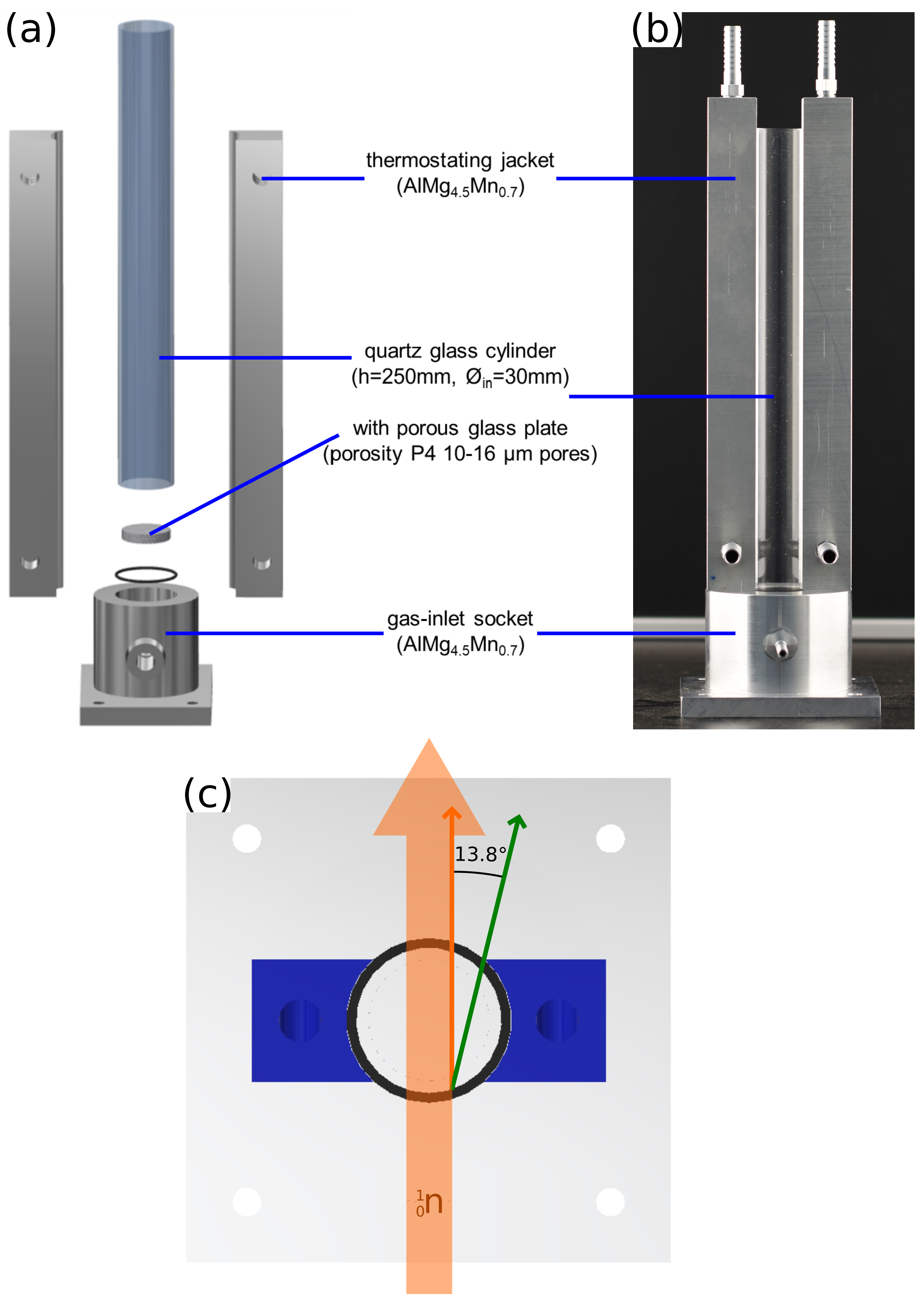
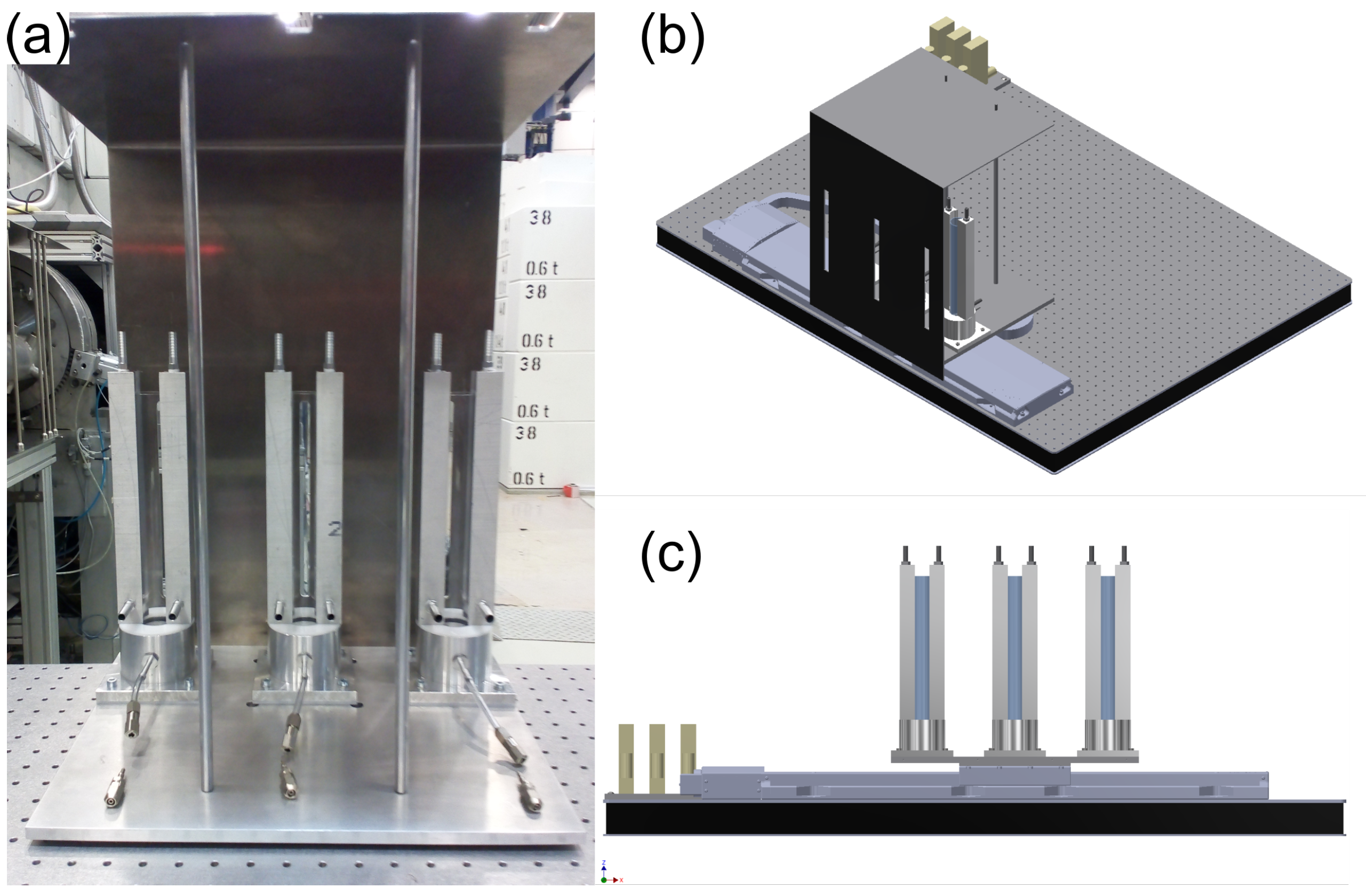
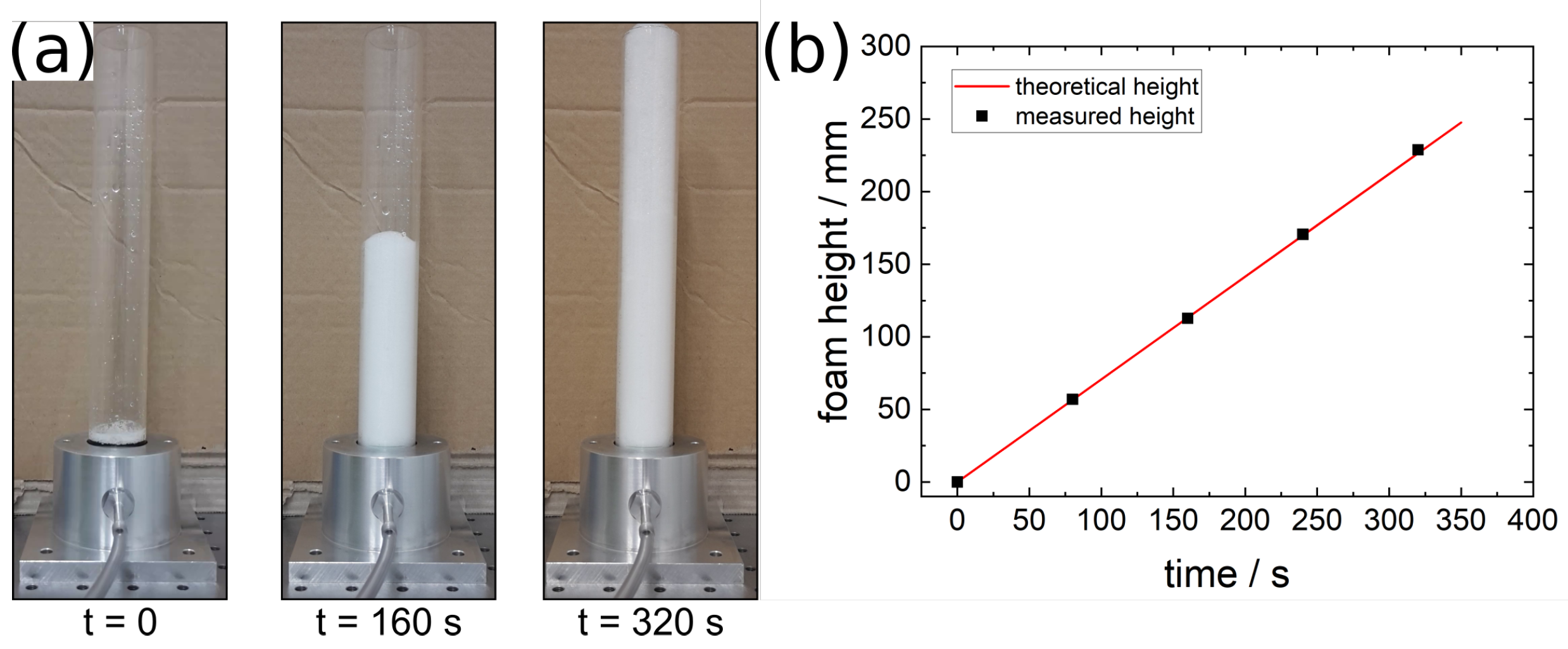
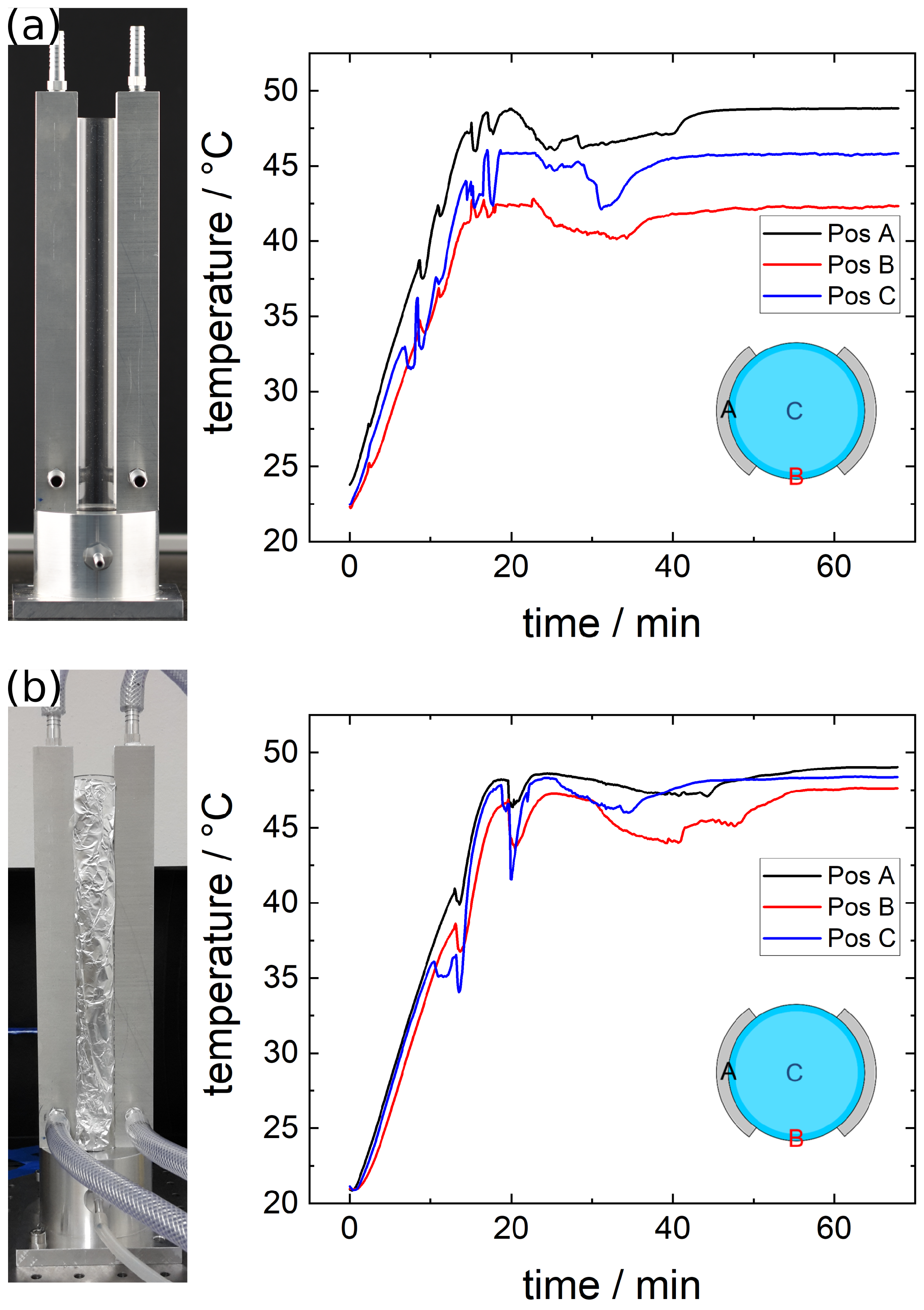
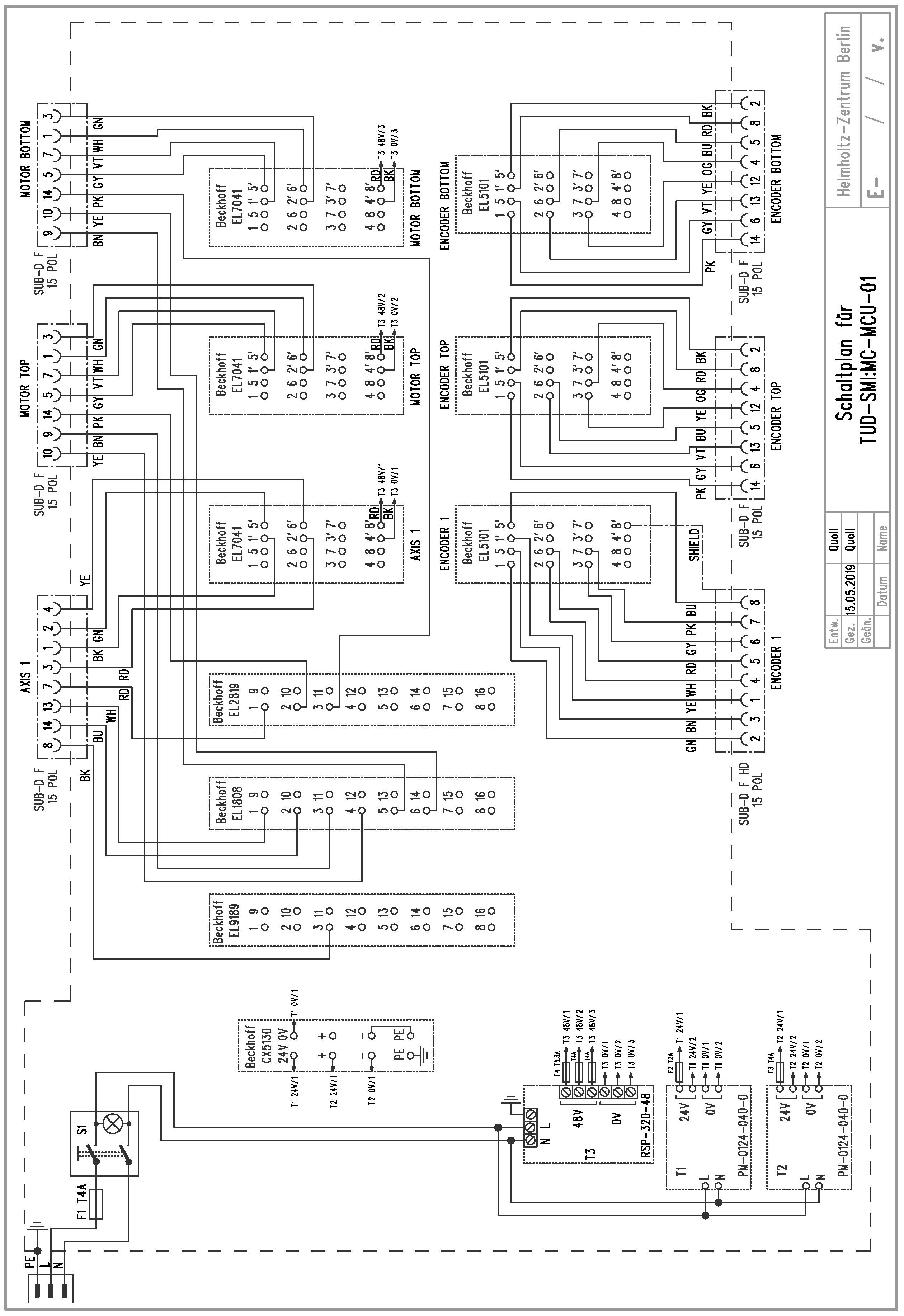

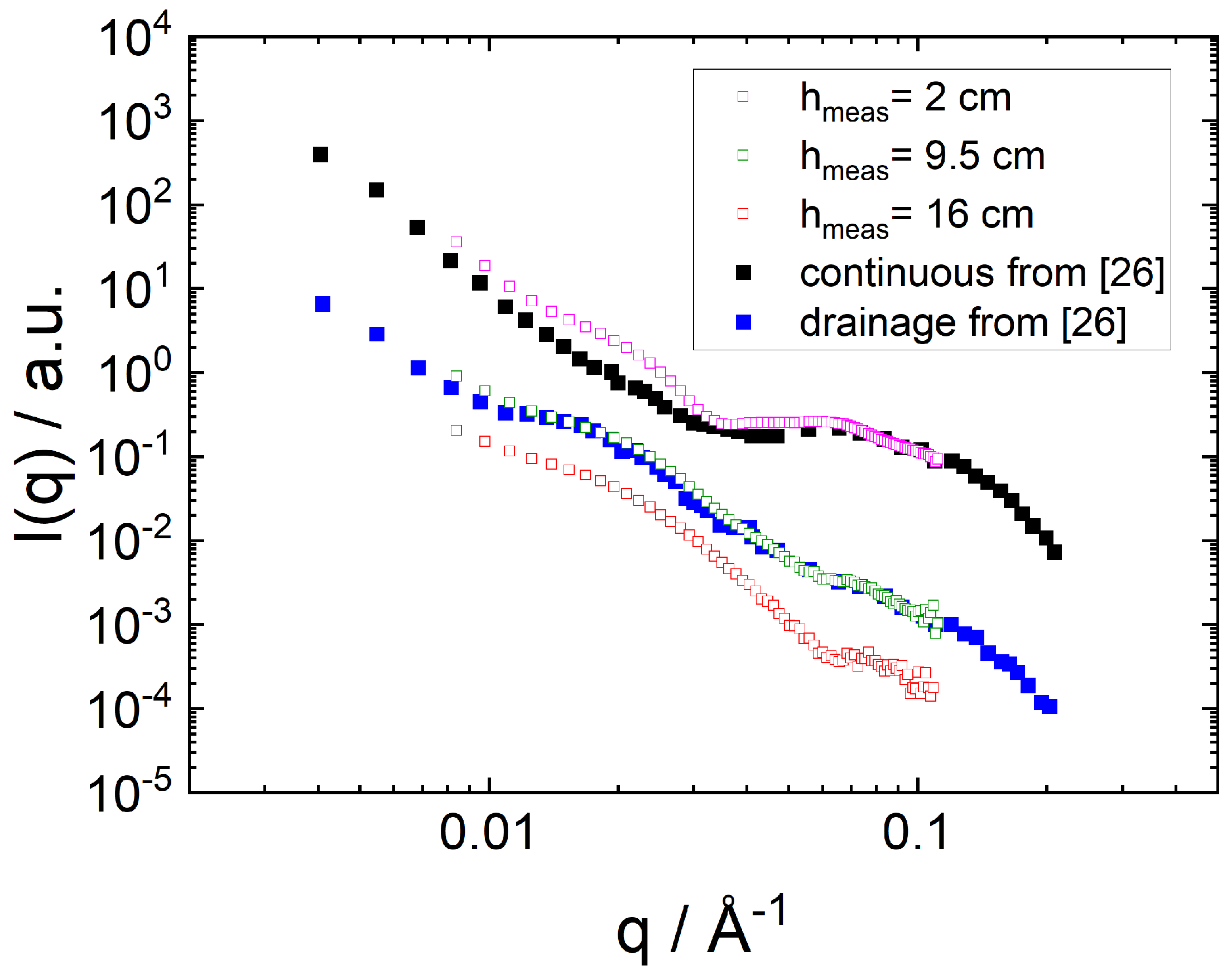
Publisher’s Note: MDPI stays neutral with regard to jurisdictional claims in published maps and institutional affiliations. |
© 2021 by the authors. Licensee MDPI, Basel, Switzerland. This article is an open access article distributed under the terms and conditions of the Creative Commons Attribution (CC BY) license (https://creativecommons.org/licenses/by/4.0/).
Share and Cite
Kühnhammer, M.; Widmann, T.; Kreuzer, L.P.; Schmid, A.J.; Wiehemeier, L.; Frielinghaus, H.; Jaksch, S.; Bögershausen, T.; Barron, P.; Schneider, H.; et al. Flexible Sample Environments for the Investigation of Soft Matter at the European Spallation Source: Part III—The Macroscopic Foam Cell. Appl. Sci. 2021, 11, 5116. https://doi.org/10.3390/app11115116
Kühnhammer M, Widmann T, Kreuzer LP, Schmid AJ, Wiehemeier L, Frielinghaus H, Jaksch S, Bögershausen T, Barron P, Schneider H, et al. Flexible Sample Environments for the Investigation of Soft Matter at the European Spallation Source: Part III—The Macroscopic Foam Cell. Applied Sciences. 2021; 11(11):5116. https://doi.org/10.3390/app11115116
Chicago/Turabian StyleKühnhammer, Matthias, Tobias Widmann, Lucas P. Kreuzer, Andreas J. Schmid, Lars Wiehemeier, Henrich Frielinghaus, Sebastian Jaksch, Torsten Bögershausen, Paul Barron, Harald Schneider, and et al. 2021. "Flexible Sample Environments for the Investigation of Soft Matter at the European Spallation Source: Part III—The Macroscopic Foam Cell" Applied Sciences 11, no. 11: 5116. https://doi.org/10.3390/app11115116







